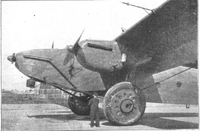Beardmore Inflexible
The Beardmore Inflexible, also known as the Rohrbach Ro VI, was a three-engined all-metal prototype bomber aircraft built by William Beardmore and Company at Dalmuir, Scotland.
| Inflexible | |
|---|---|
 | |
| Beardmore Inflexible at the Norwich Air Display, RAF Mousehold Heath, May 1929 | |
| Role | Experimental Transport |
| Manufacturer | Beardmore |
| Designer | Dr Rohrbach[1]/W.S Shackleton |
| First flight | 5 March 1928 |
| Introduction | 1928 |
| Retired | 1930 |
| Status | Retired |
| Primary user | Royal Air Force |
| Number built | 1 |
Design and development

William Beardmore and Company had acquired a licence for the use of the Rohrbach principle for stressed-skin construction. Using these principles and drawings supplied by Rohrbach for the RoVI, the Beardmore company designed, what was then a massive all-metal three-engined transport, the Beardmore Inflexible.
The aircraft (Serial Number J7557) was built in sections at Dalmuir between 1925 and 1927 and these were sent by sea to Felixstowe and from there delivered by road to the Aeroplane & Armament Experimental Establishment (A&AEE) at Martlesham Heath Airfield where it first flew on 5 March 1928,[2] appearing at the Hendon RAF Display later in the year. The aircraft was structurally advanced for its time and had good flying qualities. It was also a very large aircraft for the time, having a wingspan of 157 feet (48 m) - around 16 feet (4.9 m) greater than the Boeing B-29 Superfortress heavy bomber of World War II. However, with an all up weight of 37,000 pounds (17,000 kg). it suffered from being underpowered and, with no interest in production, the aircraft was dismantled at Martlesham Heath in 1930. It was then used to investigate the effects of corrosion on light-alloy stressed skin structures.
One of the aircraft's wheels survives, and is an exhibit in the Science Museum, London.
Specifications
Data from Air Enthusiast International [2]
General characteristics
- Length: 75 ft 6 in (23.02 m)
- Wingspan: 157 ft 6 in (48.05 m)
- Height: 21 ft 2 in (6.45 m)
- Wing area: 1,967 sq ft (182.8 m2)
- Empty weight: 24,301 lb (11,022 kg)
- Max takeoff weight: 37,000 lb (16,783 kg)
- Powerplant: 3 × Rolls-Royce Condor II V12 piston engine, 650 hp (485 kW) each
Performance
- Maximum speed: 109 mph (175 km/h, 95 kn)
See also
Related development
Aircraft of comparable role, configuration and era
Related lists
References
Notes
- Flight 5 July 1928 p539 "although the design staff at Dalmuir, headed by Mr. W. S. Shackleton...naturally did a large amount of the detail work."
- Air Enthusiast International March 1974, p.145.
Bibliography
- "THE BEARDMORE "INFLEXIBLE". Flight. 5 April 1928. pp. 225–226.
- The Illustrated Encyclopedia of Aircraft (Part Work 1982-1985). Orbis Publishing.
- Jackson, A.J. (1974). British Civil Aircraft since 1919. London: Putnam. ISBN 0-370-10014-X.
- "Plane Facts". Air Enthusiast International. Vol. 6 no. 3. Bromley, UK: Fine Scroll. March 1974. p. 145.
- Taylor, Michael J. H. (1989). Jane's Encyclopedia of Aviation. London: Studio Editions. p. 123.
External links
| Wikimedia Commons has media related to Beardmore Inflexible. |
- Film clip of the Inflexible taxiing and taking off at the Norwich Air Display, May 1929; Pathé News online archive.